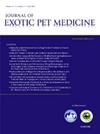Blood and urinalysis measurements in ferrets with clinically suspected chronic kidney disease
IF 0.6
4区 农林科学
Q4 VETERINARY SCIENCES
引用次数: 0
Abstract
Background
Chronic kidney disease (CKD) is probably underdiagnosed in ferrets. Laboratory data of ferrets with CKD are lacking and no staging or treatment guidelines are available in this species. The purpose of this study was to evaluate potential blood and urinary biomarkers beyond urea and creatinine in diagnosing CKD in ferrets.
Methods
A retrospective study using blood and urine results from ferret suspected of having clinical CKD as well as 60 clinically healthy pet ferrets in a private practice specializing in exotic animals was conducted. Selected variables related to renal function including red blood cell count, albumin, urea, creatinine, total calcium, inorganic phosphate (P), symmetric dimethylarginine (SDMA), urine specific gravity (USG) and urine protein creatinine ratio (UPC ratio) were compared to a clinically healthy population. Diagnostic performance of serum urea, creatinine and SDMA were evaluated using receiver operator characteristic (ROC) curves.
Results
Statistically significant differences were found between the results of the 2 groups for all variables except for P. Ferrets from both groups had lower serum creatinine (median 73 µmol/L; 0.82 mg/dL in the CKD and 40 µmol/L; 0.45 mg/dL in the healthy group) and SDMA (median 7.45 µg/dL in the CKD and 5.1 µg/dL in the healthy group) values than described in dogs and cats. Ferrets with suspected CKD exhibited lower USG (1018 ± 6.71) and higher UPC ratio (median 1.86) compared to healthy animals (1039 ± 12.67 and median 0.23). The diagnostic value of serum creatinine (AUC = 0.807) was higher than that of urea (AUC = 0.720) or of SDMA (AUC = 0.713) for detecting CKD based on ROC analysis.
Conclusions and clinical relevance
The use of species-specific reference intervals is mandatory to recognize mild changes in renal function in ferrets. Urinalysis, including the measurement of USG and UPC ratio, can facilitate the diagnosis of CKD and are recommended in all ferrets with suspected renal disease.
临床怀疑患有慢性肾脏疾病的雪貂的血液和尿液分析测量
背景:慢性肾脏疾病(CKD)在雪貂中可能未被充分诊断。目前缺乏慢性肾病雪貂的实验室数据,也没有针对该物种的分期或治疗指南。本研究的目的是评估除尿素和肌酐外,雪貂CKD诊断中潜在的血液和尿液生物标志物。方法对60只临床健康宠物雪貂和疑似临床CKD雪貂的血液和尿液进行回顾性研究。选择与肾功能相关的变量,包括红细胞计数、白蛋白、尿素、肌酐、总钙、无机磷酸盐(P)、对称二甲基精氨酸(SDMA)、尿比重(USG)和尿蛋白肌酐比(UPC),与临床健康人群进行比较。采用ROC曲线评价血清尿素、肌酐和SDMA的诊断效能。结果两组除雪貂外,其他变量的结果均有统计学差异,两组雪貂血清肌酐均较低(中位数73µmol/L;CKD为0.82 mg/dL, 40µmol/L;(健康组为0.45 mg/dL)和SDMA (CKD中位数为7.45 μ g/dL,健康组为5.1 μ g/dL)值比狗和猫的描述值高。疑似CKD的雪貂USG值(1018±6.71)低于健康动物(1039±12.67,中位数0.23),UPC值(中位数1.86)高于健康动物(中位数0.23)。基于ROC分析,血清肌酐(AUC = 0.807)对CKD的诊断价值高于尿素(AUC = 0.720)或SDMA (AUC = 0.713)。结论和临床意义使用物种特异性参考区间是识别雪貂肾功能轻微变化的必要条件。尿液分析,包括USG和UPC比值的测定,有助于CKD的诊断,建议所有怀疑有肾脏疾病的雪貂都进行尿液分析。
本文章由计算机程序翻译,如有差异,请以英文原文为准。
求助全文
约1分钟内获得全文
求助全文
来源期刊

Journal of Exotic Pet Medicine
农林科学-兽医学
CiteScore
1.20
自引率
0.00%
发文量
65
审稿时长
60 days
期刊介绍:
The Journal of Exotic Pet Medicine provides clinicians with a convenient, comprehensive, "must have" resource to enhance and elevate their expertise with exotic pet medicine. Each issue contains wide ranging peer-reviewed articles that cover many of the current and novel topics important to clinicians caring for exotic pets. Diagnostic challenges, consensus articles and selected review articles are also included to help keep veterinarians up to date on issues affecting their practice. In addition, the Journal of Exotic Pet Medicine serves as the official publication of both the Association of Exotic Mammal Veterinarians (AEMV) and the European Association of Avian Veterinarians (EAAV). The Journal of Exotic Pet Medicine is the most complete resource for practitioners who treat exotic pets.
 求助内容:
求助内容: 应助结果提醒方式:
应助结果提醒方式:


